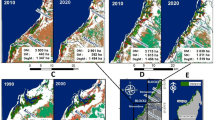Abstract
The main objective of our investigations is to find out the primary geochemical properties of insular landscapes in order to ascertain the landscape stability on an area of land uplifting in the conditions of a regressive sea. Therefore we focus our study on the landscapes of Kolga Bay islets, which are located near the Estonian coast in the Gulf of Finland. A landscape-geochemical approach of landscape study improves the mapping of insular landscapes and understanding of processes of landscape development. Besides land use changes, land uplift and marine influence shape the landscape patterns of island through topography and subsurface water. We propose geochemical typology of landscapes based on substance movement (eluvial, superwatery, subwatery), field studies on islands, and chemical analysis of soil and water samples. From a landscape geochemical perspective, types of matter fluxes mainly control stability of an insular landscape. Interactions between geochemical, ecosystem and geomorphic processes reveal that islands behave as systems, rather than merely a sequence of interdependent soil-vegetation complexes along topographic gradients.
Similar content being viewed by others
REFERENCES
Chorley R.J. and Kennedy B.A. 1971. Physical Geography. A Systems Approach. Prentice Hall, London, UK.
Forman R.T. and Gordon M. 1986. Landscape Ecology. John Wiley & Sons, New York, New York, USA.
Fortescue J.A.C. 1980. Environmental Geochemistry: A Holistic Approach. Springer-Verlag, New York, New York, USA.
Glazowskaya M.A. 1964. Geochemical Fundamentals of Typology and Research Technics of Natural Landscapes., Moscow, Russia, (In Russian).
Glazowskaya M.A. 1981. Theory of landscape geochemistry ap-plied to investigate technogenic flows and to analyse the ability of natural systems to self–purification. In: Technogenic Flows of Matter in Landscapes and State of Ecosystems. Nauka Publishers, Moscow, Russia, pp. 7–41, (In Russian).
Howard J.A. and Mitchell C.W. 1980. Phyto-geomorphic classifi-cation of the landscape. Geoforum 11: 85–106.
Jansson A.M. 1991. Ecological consequences of long-term land-scape transformations in relation to energy use and economic development. In: Folke C. and Kåberger T. (eds), Linking the Natural Environment and the Economy: Essays from the Eco-Group. Kluwer Academic Publishers, Dordrecht, The Netherlands, pp. 97–110.
Zonneveld I.S. 1994. Basic principles of classification. In: Klijn F. (ed.), Ecosystem Classification for Environmental Manage-ment. Kluwer Academic Publishers, Dordrecht, The Nether-lands, pp. 23–47.
Kärblane H. (ed.) 1996. Handbook of Plant Nutrition and Fertili-zation. Estonian Ministry of Agriculture, Tallinn, Estonia, (In Estonian).
Milne G. 1936. A provisional soil map of East Africa. East African Agriculture Research Station, Amani Memoirs, Tanganyika Territory. In: Fanning D.S. and Fanning M.C. (eds), Soil. Mor-phology, Genesis, and Classification. J. Wiley & Sons, New York, New York, USA, (1989) p. 361.
Noble I.R. 1999. Effect of landscape fragmentation, disturbance, and succession on ecosystem function. In: Tenhunen J.D. and Kabat P. (eds), Integrating Hydrology, Ecosystem Dynamics, and Biogeochemistry in Complex Landscapes. John Wiley & Sons, Chichester, UK, pp. 297–312.
Paal J. 1997. Classification of Estonian Vegetation Site Type. Estonian Environment Information Centre, Tallinn, Estonia, (In Estonian).
Peil T. 1999. Islescapes. Estonian Small Islands and Islanders Through Three Centuries. Acta Universitatis Stockholmiensis. Stockholm Studies in Human Geography 8. Almqvist & Wik-sell International, Stockholm, Sweden.
Perelman A.I. 1975. Landscape Geochemistry (Geohimiya Land-shafta). Wyshaya Shkola, Moscow, Russia, (In Russian).
Polynow B. 1956. Selected Works. Akademia Nauk SSSR, Moscow, Russia, (In Russian).
Puurmann E. and Ratas U. 1990. Saline maritime soils of West-Estonia. Soviet Soil Sciences 22: 25–31.
Ratas U., Mägi E. and Puurmann E. 2000. Impact of birds on the development of landscape of Estonian small islands. In: Estonia. Geographical Studies. Estonian Academy Publishers, Tallinn, Estonia, pp. 124–139.
Ratas U., Nilson E., Kont A., Puurmann E., Kokovkin T., Truus L. et al. 1997. Insular landscape. In: Ratas U. and Nilson E. (eds), Small Islands of Estonia. Landscape Ecological Studies. Insti-tute of Ecology, Tallinn, Estonia, pp. 66–130, Publication 5.
Ratas U. and Puurmann E. 1995. Human impact on the landscape of small islands in West-Estonian archipelago. Journal of Coastal Conservation 1: 119–126.
Ratas U., Puurmann E. and Kokovkin T. 1988. Genesis of Islets Geocomplexes in the Väinameri (the West-Estonian Inland Sea). Acad. Sci. Estonian S.S.R. Department of Chemistry, Ge-ology and Biology, Tallinn, Estonia.
Vallner A., Sildvee H. and Torim A. 1988. Recent crustal movements in Estonia. Journal of Geodynamics 9: 215–223.
Vestergaard P. 1978. Studies in vegetation and soil of coastal salt marshes in the Disko area, West Greenland. Meddr. Gronland. 204: 1–51.
Vilberg G. 1933a. Vegetation of North-Estonian islands. I.–Sit-zungsberichte der Naturforscher-Gesellschaft bei der Universität. Tartu 39: 131–168, (In Estonian).
Vilberg G. 1933b. Vegetation of North-Estonian islands. II. Sitzungsberichte der Naturforscher-Gesellschaft bei der Univer-sität. Tartu 39: 231–292, (In Estonian).
Zonneveld I.S. 1989. The land unit–a fundamental concent in landscape ecology and its applications. Landscape Ecology 3: 67–86.
Author information
Authors and Affiliations
Rights and permissions
About this article
Cite this article
Ratas, U., Puurmann, E., Roosaare, J. et al. A landscape-geochemical approach in insular studies as exemplified by islets of the eastern Baltic Sea. Landscape Ecology 18, 173–184 (2003). https://doi.org/10.1023/A:1024480501983
Issue Date:
DOI: https://doi.org/10.1023/A:1024480501983



